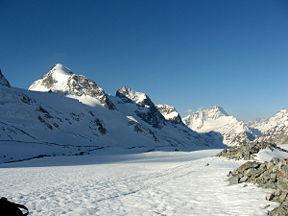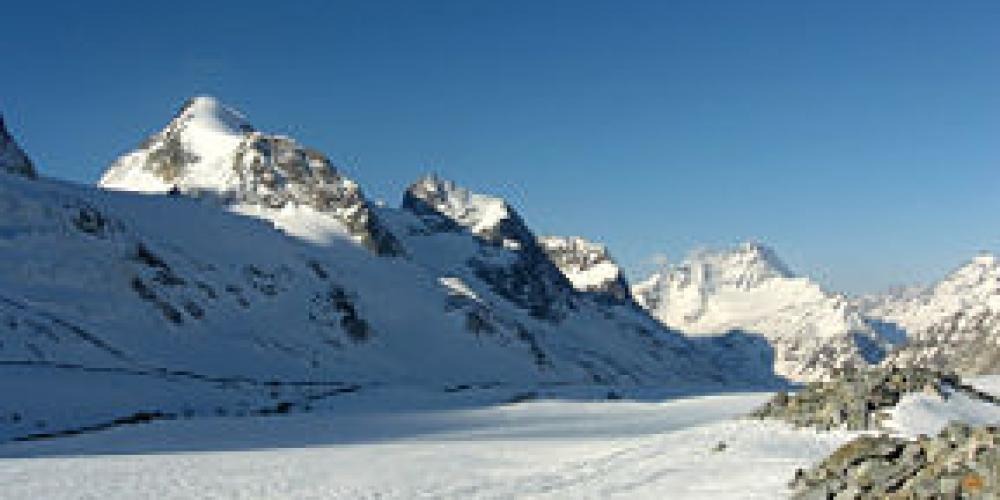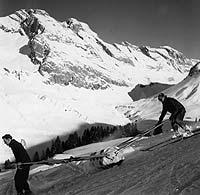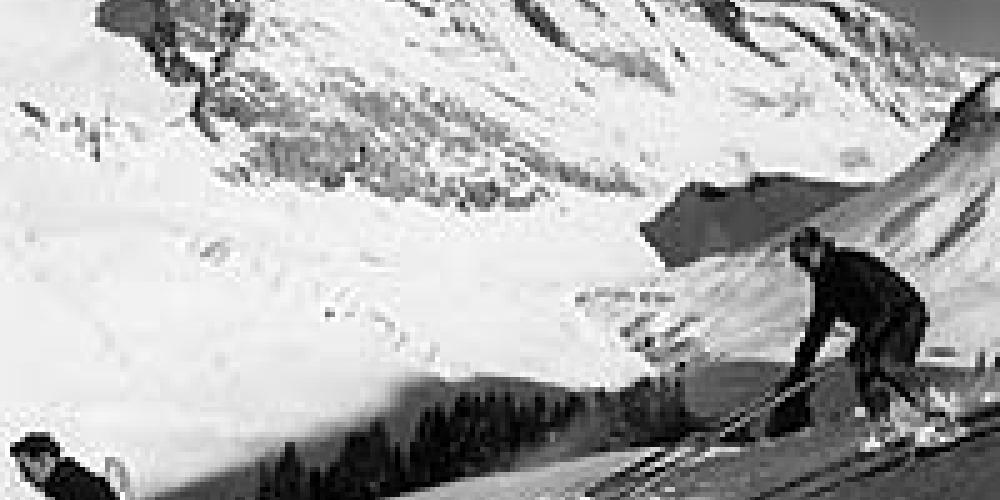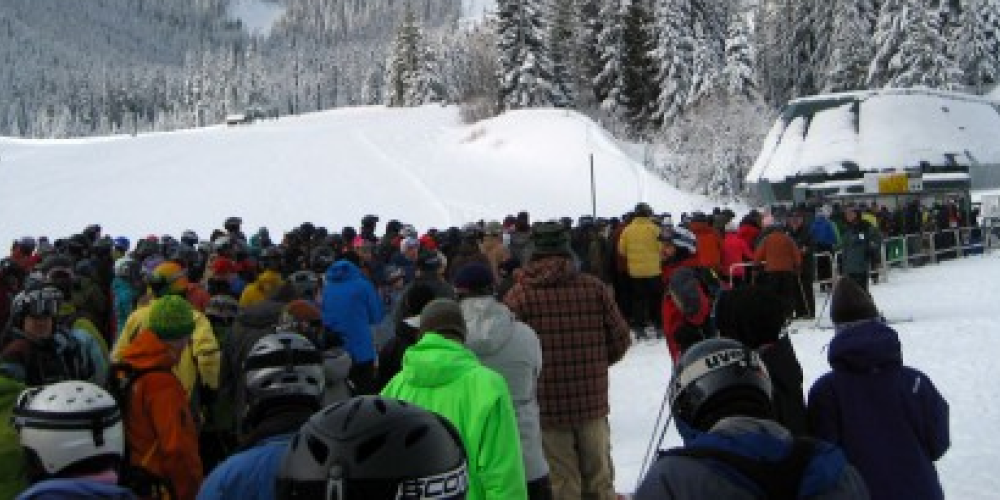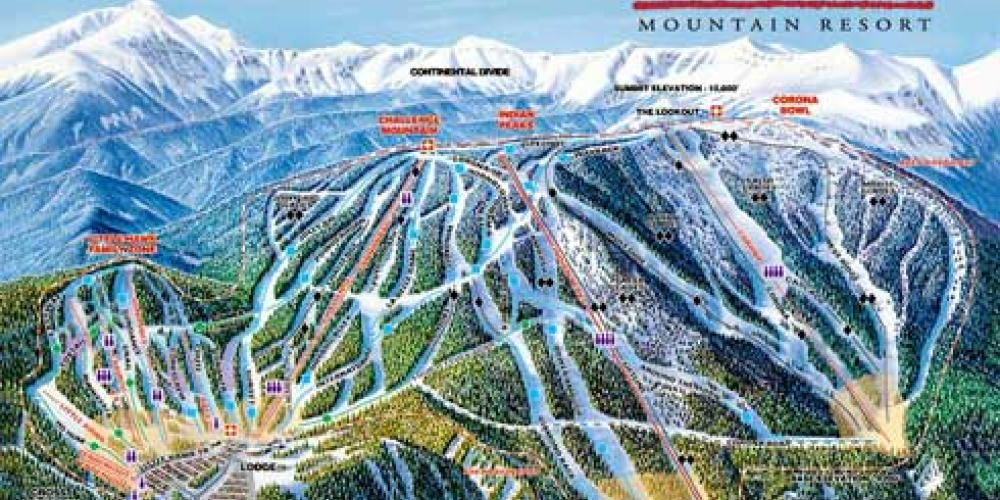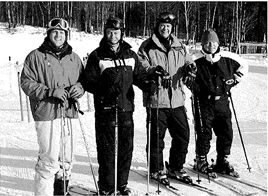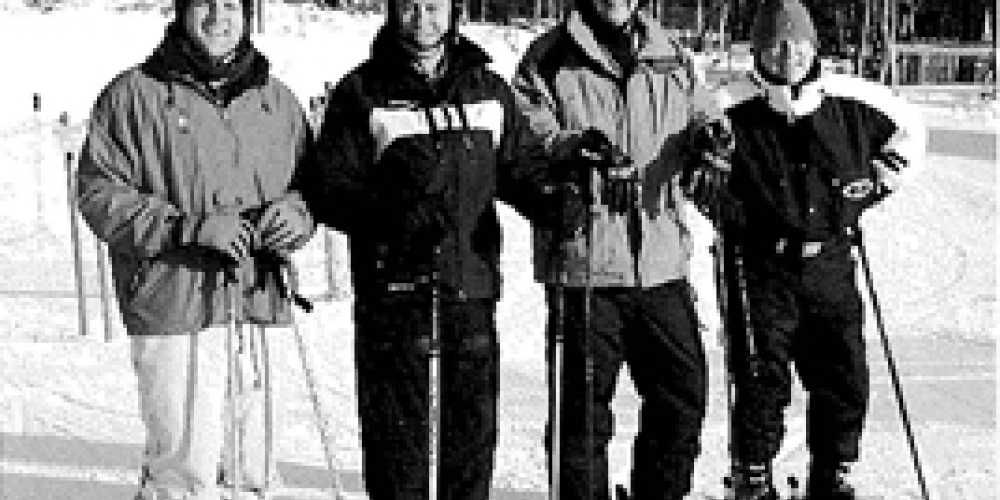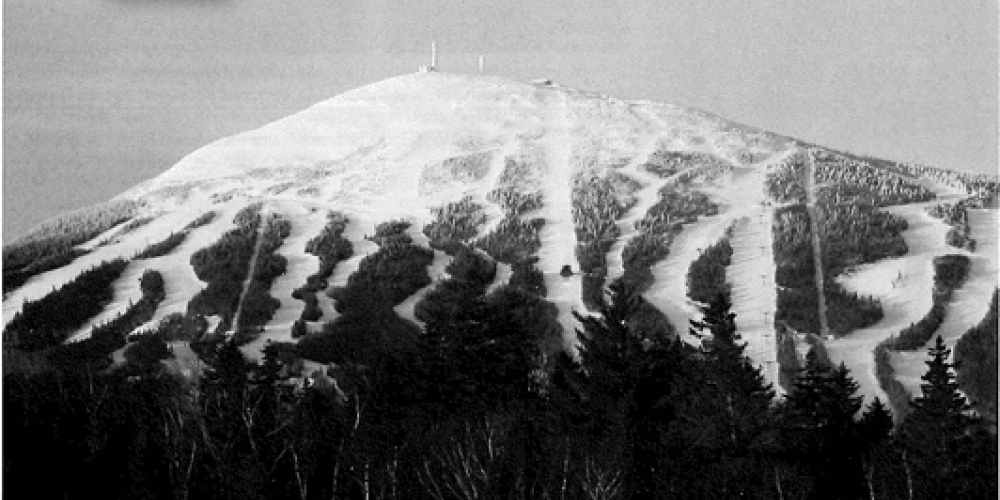Even a trivial challenge can change your life.
By Seth Masia
1983 was the 80th anniversary of the “tourist” route from Chamonix to Zermatt, a high traverse of about 100km across the glaciers, cols and couloirs through the Waliser Alps. To celebrate, the Swiss National Tourist Office invited about 40 big-city travel writers to ski sections of the route. They were to be lofted by helicopter each morning and lifted out in late afternoon to luxury hotels in neighboring ski resorts. This seemed like arrant nonsense to me. I’d never done the Haute Route myself, but considered it an insult to Alpine tradition in general to put New York Times travel writers onto its easier downhill pitches for purposes of publicity.
I wanted to write about a home-rolled Haute Route adventure, one with a challenging twist. In the American Rockies, a new form of “norpine” skis was gaining popularity along with the revival of interest in telemark skiing. Norpine skis were traditional Nordic touring skis – about 55mm wide and as straight as a running ski – with fiberglass construction and steel edges. We used them with old-fashioned 3-pin cross country bindings and leather mountaineering boots, though for improved leverage I pulled out the floppy felt bootliners and instead used the high leather bladders from an old pair of Nordica slalom boots. With Bob Jonas of Sun Valley Trekking, I’d spent a week crossing the Sawtooth range on norpine skis. They didn’t float very well in deep snow, but were lighter and more comfortable for long gentle climbs than alpine touring or randonée gear. The most popular randonée gear of the era consisted of the Rossignol Haute Route ski – a wide and heavy aluminum truck – with Silvretta cable bindings and plastic alpine touring boots. I’d tried climbing with this rig and it felt clumsy. I didn’t like the mechanical clank as the Silvrettas slammed home on every stride. The organic flex of a leather cross country boot felt much more comfortable. I figured that, weather permitting, the lighter norpine gear would let my group zip from Chamonix to Zermatt in five days, and on to Saas-Fee on the sixth.
Mountain guides often say they can haul any strong recreational skier along the Haute Route, but it is serious mountaineering terrain. One day requires 6000 feet of climbing, there are several nasty steep couloirs to negotiate, and the long glacial sections are riddled with crevasses (on average, one person dies each day in the mountains above Chamonix, and the Mont Blanc massif alone kills more climbers in a year than Alaska’s mountains kill in a decade). Avalanche is a persistent danger. Most Europeans who had traversed the Route considered skinny skis entirely inappropriate for the icy spring snow and steep descents. But I was determined to show up the helicopter-riding woosies.
I had a friend of like mind. Stan Tener was (and still is) a professional ski patroller at Snowmass, a member of their avalanche control team, and a good climber. He thought telemarking the Alps might be a groovy thing. Stan had never been to Europe, so he didn’t know what he was getting into. He was competent and brave, but deluded – a perfect partner for this trip.
The climber and writer David Roberts once said that the way to get into trouble in the mountains is to have a point to prove. Roberts might say that the only reason Stan and I didn’t get into serious trouble was that the point we had to prove wasn’t serious.
Stan and I loaded our new 210cm Phoenix skis (made in Boulder) and our well-worn leather boots and our ambitious butts onto an Air France 747, along with about 10,000 Parisians headed home for Easter. We hooked up with photographer Del Mulkey at Val d’Isère, where we found out that the skis worked pretty well on groomed terrain and in open powder bowls. Del was a former University of Montana ski racer who lived in the South of France and knew a lot more about travel in the Alps than we did. He had already skied the Haute Route a couple of times, and had also skied high into the Himalaya. Del refused to give up his 190cm Rossignol Haute Route randonée skis and plastic boots.
I had also arranged for an experienced French climber to guide us, but when we arrived in Chamonix he was nowhere to be found, and didn’t answer his phone. So we went without him. We spent a morning stocking up on bargain climbing gear in the Chamonix sports shops, and a long lunch marking alternate routes on our topo maps, and researching weather forecasts. The metéo said the weather would be fine for at least the next two days. Late in the afternoon we dragged our 35-pound packs onto the Argentière tram and rode up 9000 vertical feet, high into a clear Alpine evening.
I had learned to telemark only that winter, in soft, forgiving Idaho snow. What we found at the summit of the Grands Montets, at 10,800 feet, was not Idaho powder, but moguls made of concrete. When I fell, the pack swung forward like a hammer, pounding my face into the ice.
Del was amused. “You want to go back to town tonight and get some real skis,” he advised dryly. He skied away, bobbing smoothly through the bumps with his heels locked sensibly down, to the glacier 2200 feet below. Stan and I gritted our teeth and followed. Our skis, it now became clear, had a nordic flex pattern, with a stiff wax pocket underfoot that would not flex. Forcing these javelins between moguls was not doable in anything resembling telemark style. We swiveled and cursed our way along, in a ragged parallel technique.
Out on the glacier, we skinned up for the short ascent to the huge Argentière refuge, first of the Haute Route huts. Like most of the high-country huts, the place is a fortress, with dressed stone walls two feet thick so as to withstand any storm or avalanche. Argentière squats against a wall of rock above the edge of the glacier, and we found it packed full of cheerfully noisy (and noisome) climbers either finishing up or starting out on a Haute Route trip.
From Stan’s diary (April 25): Packs too heavy even though we have minimum gear. I’m scared of crevasses on the glacier. The hut is crowded with Japanese, Germans, Austrians, and French – there’s even a film crew. We are sort of celebrities for turning up on skinny skis. One of the hottest cross country skiers in Europe is here, just finishing up the route, and he had a lot of trouble. I’m relieved to hear it. It means the problem really is the skis, and not me.
I wasn’t in the least relieved to hear it. If the problem were me, I might learn fast enough to master it. But if the problem were the skis, things would get worse instead of better as we proceeded into more gnarly terrain. I rationalized that our speed on the climbs would compensate for our incompetence on the descents, but I worried that I might have bit off too big a chaw.
Well before dawn on April 26, we traversed over to the foot of Chardonnet Glacier. There we put on our new crampons, tied the skis to the packs, and began the steep 2500-foot climb to the top of the world. The snow was cold, firm and stable all the way up, and the crampons crunched with each step. Stan lives at 8000 feet, so the altitude didn’t bother him. He shouldered the heaviest load and stormed right up. Del and I both lived at sea level. Del, at age 52, was in awesome shape, and moved like a camel, slowly and steadily, refusing both drink and rest. Manfully, I took up the rear guard. I caught up with them at the 10,900 foot Col de Choidon, sitting on their packs and arguing about the correct way to grip an ice axe. Stan, with his Viking complexion, grew red in the face with exasperation. Del, weatherbeaten and leathery, just smiled quietly, and shook his head in tolerance of misguided youth.
Stan’s diary: Breakfast in the dark and moving by 5:30. Del takes us a wrong turn and we end up climbing a steep dangerous neve. Because Seth’s skis are stiffer and more stable than mine, we agree that I’ll carry the heavy pack up and he’ll carry it down. Del doesn’t want to hold his axe properly.
We traversed and climbed to the Fenêtre de Saleinez, the border into Switzerland. No customs to pass. Instead, we looked down 600 feet of nasty narrow couloir to the Saleina Glacier. There appeared to be a skiable route somewhere over to the left, but to get there we’d need to traverse and climb another hour around the north side of the peak. A party of Japanese skiers, led by a guide, had come up behind us and headed that way.
We elected to rappel down the couloir, and did it in three pitches, sending a man down, lowering the packs to him, then regrouping. At the bottom, with our skis back on, we could see over to the “skiable” route. It looked a bit broader and shallower, and I wouldn’t hesitate to ski it on alpine gear. But the Japanese were roping down, and had stopped to pull one of their party out of a crevasse.
Stan’s diary: Crampons to narrow col. Belay down and waste much time. Rope comes short of worst part but Seth and Del do admirable job. See the correct route when we get down – we are stupid and lucky. Hear about Japanese lady falling into crevasse.
We traversed the top of the glacier, climbed to the Plateau du Trient, and had lunch at the Porte d’Orny, another col, at 10,700 feet.
“So far those skis of yours are working out great,” Del said around a mouthful of lard, the raw bacon he loved. “I haven’t seen you guys do a telemark turn yet.”
It was true. The snow was hard and so steep that on some of the traverses the corners of my pin bindings levered the edges of the skis right off the ice. On our shorter descents it was a hell of a lot easier just to throw the skis into a series of parallel sideslips and hope for the best. From the Porte, however, we now looked at a wonderful five-mile run down the Val d’Arpette to the Swiss village of Champex. The only problems were the late afternoon avalanches roaring down the neighboring gullies, and breakable crust that trapped our long, stiff, narrow skis and kept them arrowing straight toward mile-deep crevasses. Because directional control was questionable, I tended to hug the edge of the glacier, far from the deepest crevasses but uncomfortably close to the overhanging couloirs. Stan screamed at me to get out from under Falling Death.
Stan’s diary: Snow impossible to ski. Seth having great trouble. Seth and Del like to stand around in avalanche danger and get impatient with me when I tell them to wake up or die. A slow and difficult descent to Champex.
Actually, the run down to Champex was a breeze for Del. His short fat randonée skis floated over the crust and slush with style. When Stan and I finally arrived at the village, he was perched on the edge of a flagstone deck, in the sun, guarding a row of cold beer bottles.
“These are the Alps, Seth my boy,” he said. “Why do you think we call them alpine skis?”
We had taken nine hours to make the ten miles over from Argentière. That’s not brilliant speed, but what the hell. I suppose we might have done it faster by helicopter. I learned later that few of the 40 travel writers reached Champex in time for their evening lift, and most had to ride a bus out in the dark. We drank our beers and got the public bus downvalley to Bourg St.-Pierre, with a dozen other Haute Routiers. There, hot showers awaited in a comfy little hostelry on the south edge of town.
On April 27 we slept in, getting a big breakfast and hiking off at 9:30 for the climb to Valsorey. The trail winds for just over six kilometers, but climbs 4600 feet. My rule of thumb for planning hikes says two miles per hour, plus an hour for every thousand feet gained. At that pace, I figured the climb to take six and a half hours, but Del said “It’s five,” and set out to prove it. We walked the first third on Vibram soles, passing among cows and goats, then were on and off our skis for a couple of hours through mixed snow and rock in spectacular country. Much of the way we climbed along a cascading stream, fat with spring runoff. So it was easy to refill our water bottles and I cooled my face in the bracing icy pools. Whenever we stopped to refresh, Del just kept slogging upward, and was soon high above.
Stan’s diary: Long hot climb. Del won’t drink. He’s stubborn, and eats raw lard. I’m surprised, because he has been in extreme mountain conditions all over the world.
Finally we emerged from the gulleys onto the snowfields, climbing on skins. The weather held, supplying crystal air and severe blue skies. We hadn’t seen a cloud in three days, and the breeze blew steady and dry from the north. In the Alps, a north wind brings clear Scandinavian air. Del and I were both wrong about my climbing time: seven and a half hours after starting, I finally caught up with Del and Stan resting outside the wonderful little Valsorey hut.
This hut was put up in 1901. Under the sharply pitched roof, it’s a stone cube, no more than 20 feet on a side. The interior is built like a yacht, with bunks that fold out of the overhead everywhere. The kitchen and dormitories together can sleep over 40 climbers comfortably. The view is incredible. We had it more or less to ourselves. In addition to the gardiens, a young Suisse romand couple, we supped with a friendly party of five Dutch and an Austrian father-son team. What you want in a high alpine meal is a lot of calories. We ate thick soup, fried eggs with beans and potatoes, and fruit cocktail in kirsch.
The hut perches on a south-facing point below the Grand Combin, overlooking the Valsorey Glacier and the Velan hut, far off on the other side of the valley. We watched the sun set from this eyrie, melted a few quarts of water for our bottles, and crawled away to bed.
Day Four, April 28, began in the dark, with the rattle of packs and the shuffling of slippers on the wooden floor. The Dutch were up and moving at 3:00 am, heading off to climb the Grand Combin.
Three hours later we left Valsorey, climbing two hours eastward toward the first light and the 12,000 foot Col du Sonadon. As usual, Del and Stan waited for me at the top. Fortunately, they always found something to argue about while waiting. This morning Stan wanted to navigate by the map, while Del wanted to follow the tracks worn deep in the settled spring snow after a week of fine weather. I looked at the map, and it seemed to me that the tracks went in the right direction, so I cast the deciding vote and off we went down the Mont Durand glacier. Then it was up another thousand feet to Chanrion. En route we overtook the Austrians again. We found them sitting on a steep traverse, contemplating the son’s broken ski. I gave them some duct tape and we pressed on.
Chanrion hut is big, and remote. We were moving faster now, and got there early, at 1:30. I sat happily on the sun-warmed stone deck most of the afternoon, barefoot and stupid. The Dutch party arrived later, proud and pleased by their Grand Combin traverse. The gardien told us that the hut was built in 1890, and in all that time it’s had only four gardiens, from two related families.
Before supper, the place filled with workmen from a hydroelectric project above Maupoisin. They stayed up late, drinking beer, playing cards, yodeling and singing in schweizerdeutsch.
Stan’s diary: Snow nearly unskiable, but I’m skiing okay, sort of. At Chanrion, the aubergist is a big, burly guy from a long line of innkeepers. No jokes, though. No sleep because of yodeling drunk workers.
Day Five, April 29: I hoped to make this a long, final day: we’d zip up the long, gentle Otemma glacier to the Cabane de Vignettes, then cross three cols and come out at the head of a long easy descent to Zermatt. We left Chanrion before dawn. Following the bobbing beams of our headlamps, we threaded upward for a couple of miles amongst the rocks, and turned northeast onto the six-mile long Otemma Glacier. To get over to Zermatt by nightfall we would have to leave Vignettes by noon, and to get there we needed to gain about 3000 feet on the glacier – it would be a long, gradual rise. I pulled out the “klister” I had bought in Chamonix for just this climb. I expected to langlauf up the hill in an easy three hours.
It wasn’t real Scandinavian klister. A mysterious French paste wax, probably made of truffles and anchovies, oozed from the tube. It provided about as much grip as béarnaise sauce. Disappointed, we switched back to climbing skins, and made good time – so good that the abrasive snow burned the hair right off the skins. We caught up and passed a couple of dozen folks clanking along on randonée gear. At least I’d figured out what nordic skis are good for in the Alps: blasting up gentle glaciers.
One reason for our rapid progress was a strong following wind. If I’d had a tent fly to rig as a spinnaker, the wind might have towed me the whole six miles. And this was a problem. We’d lost our wonderful dry north breeze. This southwest wind, off the Azores, could be expected to bring in a warm front, and soon.
By 9:00 am, clouds had gathered in the southwest, and were moving up fast. The first snow began to fall at 10:00, as we reached the Vignettes hut. We were finally making good time – eight miles in four hours, uphill. But by the time we finished lunch the wind blew a steady 20 knots and driven snow brought the visibility down to a couple of yards. The Col de l’Evêque was an easy three-kilometer climb to the southeast, but there was no way we could find it in this blizzard. Beyond that lay another three kilometers over the steep and challenging Col du Mont Brule, and to cross it in a storm would be suicidal.
Stan’s diary: Going up the Otemma Glacier is like sailing. I wish we had wax. Wear my skins out. Weather closing in, barometer dropping. Very beautiful on glacier. As poorly as we are skiing, we’re still moving faster than 90 percent of the people we see on alpine gear.
Decision time. Theoretically, we were only five hours from Zermatt – Del said three, but he was not handicapped by youth. In decent weather we could have popped through the cols and coasted down the Zmutt Glacier in time for a tea dance. But in this visibility, we had no guarantee of being able to find the Vignettes outhouse – perched at the edge of a thousand-meter cliff – and no way at all of avoiding crevasses on the remaining ten miles of glacier.
The metéo report said this storm would last at least a couple of days. I needed to be in Annecy on May 1. So it was time to bail. We skied to Arolla, a small ski resort three miles to the north.
For me, this turned out to be the most difficult descent of the trip, just because I went blind. My glasses caked with wet, blowing snow. I caromed off the leftover moguls, then pinballed along serpentine village roads between the trees and houses. As we dropped into the calm, warm valley air, falling snow changed to a steady gray drizzle. Del and Stan were relieved when I staggered, soaked and hypothermic, into the dry dining room of a riverside inn. We drank beer and ate goulaschsuppe with the Austrian father-son team until the bus arrived to haul us out to the rail station. We rode to the terminus at Martigny and boarded the wild switchbacking cog railway over the roadless pass, through blowing storm clouds, to Chamonix.
Stan’s diary: Leave the Vignettes hut in clouds and wind. Scared of crevasses. Skiing not as good as expected. Meet Austrians at ski area. Too bad we didn’t get to Zermatt.
Too bad. We did most of our route – about three-fourths of the mileage to Saas-Fee. There will be more springtimes. The Haute Route is astonishingly beautiful. Next time I’ll start at the Saas-Fee end, just to climb in the morning light and finish in the sunset each day.
What had we proved? Not much. We demonstrated that norpine skis aren’t efficient on hard steep traverses or in spring slush. We missed a lot of good downhill skiing because we couldn’t drive an edge on steep, icy descents. But for climbing, the equipment was fast and easy.
When I got home, I took the pin bindings off the skinny skis and put them on a pair of soft floaty 195cm slalom skis, which I used very happily the following spring on a Sierra Crest tour. The wider, shorter skis held reliably on steep traverses, floated in powder and slush, and crunched through crud without getting trapped. Within five years, almost all American telemarkers would jump off norpines onto alpine-width floaters.
I learned later that the 40 travel writers rode their helicopter to Valsorey but got to Chanrion after dark and missed their lift out. They groused about primitive conditions in the hut, and about the long slog up the glacier in the morning, and about their uncomfortable plastic rental boots. They never got to Zermatt, either: they all bailed out to Arolla, most of them riding lifts down.
But the adventure changed our lives. Stunned by the immensity of the Alps, Stan went back to Chamonix a year later as an exchange patroller. He worked through the winter at the Grands Montets, and came home speaking fluent locker room French. He still patrols, as head of backcountry rescue, at Snowmass. The trip gave me the courage to quit my job in New York. I moved to Truckee and hired on to teach skiing at Squaw Valley, where I could find reliable backcountry skiing into July.
Del died in Paris in December of 2003, full of age and wisdom, red wine and raw lard.
I’m headed back to the Haute Route soon. The Swiss government reports that their average glacier is retreating at about 50 meters per year. Thanks to global warming, this rate is accelerating, and few glaciers, anywhere in the world, are expected to survive this century. Some of the smaller, steeper glaciers – the Arolla glacier contains only about a third of a cubic kilometer of ice – may not outlive me.
I’ll bring my daughter, so she can see the glaciers before they die, and tell my grand-kids about them.
I need to pay my respects.
(Photo: Ottema Glacier and the Grand Combin)
Copyright 2005 by Seth Masia. All rights reserved.

